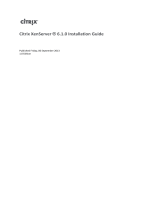
10
• License server - A component that validates licenses for Desktop Delivery Controller and
Provisioning Server. It is installed simultaneously with Desktop Delivery Controller.
• Citrix Desktop Receiver - Software running on an endpoint that enables the device to connect to a
virtual Windows XP or Vista desktop running on a server.
• Independent Computing Architecture (ICA) protocol - A communications protocol used between
endpoints and the virtual desktops. With ICA, all desktop logic executes on the desktop host. Only
screen updates, mouse clicks, and keystrokes are transmitted to the user’s computer (endpoints).
• XenDesktop Setup wizard - A wizard that automates parts of the creation, delivery, and
maintenance of large virtual desktop installations. This wizard integrates Citrix components so that
system administrators can quickly create multiple desktops.
• XenServer Tools - Tools that provide custom Windows drivers and a management agent.
XenDesktop additional components
Additional XenDesktop components provide the following features:
• Secure delivery - When users connect from outside the corporate firewall, XenDesktop can use
Citrix Access Gateway technology to secure these connections with secure sockets layer (SSL).
Access Gateway is a hardened SSL virtual private network (VPN) appliance that is deployed in the
de-militarized zone (DMZ)
1
to provide a single secure point of access through the corporate
firewall.
• Client-side application virtualization - Also known as streaming, this component enables
applications to be delivered and run in a protected, virtual environment on client devices.
Applications are first packaged by recording their installation profile and determining what is
required for streamed operation. The resulting package is stored on a file share and then
downloaded to users as required. The package is cached on the local device where it runs locally.
Normally this in isolation from other applications and processes running on the endpoint.
• Server-side application virtualization - Also known as presentation virtualization, this component
separates an application’s user interface from its program logic, enabling the user interface to be
used remotely while the program logic runs on the server. The server encrypts and sends to the
endpoint any changes to the user interface while the user’s input is returned to the server for
processing.
HP thin clients
Thin clients are at the heart of HP’s remote client portfolio of desktop virtualization solutions. Desktop
and mobile thin clients are solid-state devices that connect over a network to a centralized server
where all processing and storage takes place, providing reduced maintenance costs, minimal
application updates, higher security levels, and greater energy efficiency.
Users can access XenDesktop using the following thin client options:
• Program Neighborhood Agent (PN Agent): Using the Program Neighborhood Agent in conjunction
with the Web Interface, users can manually launch their XenDesktop session from their desktop.
• Web Client (Browser): The Web Client is used with the Browser Mode. The Web Client enables
users to access the XenDesktop group from within a familiar browser environment.
• Desktop Appliance (DA): Desktop Appliance leverages existing devices and is designed to deliver a
full desktop experience when connecting to Citrix’s XenDesktop. This mode automatically launches
XenDesktop immediately after powering on.
1
In many sites, a secure network area that sits between the corporate servers and the Internet is referred to as the DMZ. It is usually separated by
firewalls that restrict traffic flow between the corporate servers and the Internet.














